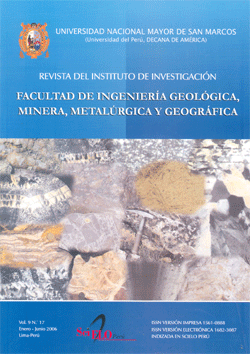Mitigacion of acid drainage in underground mines applying artificial wetland. Case: Orcopampa mine
DOI:
https://doi.org/10.15381/iigeo.v9i17.696Keywords:
Mitigation, Acid drainageAbstract
The Acid drainages of underground Mines, are one of the main sources of contamination of superficial and underground waters therefore of environment. This phenomenon can remain for a long time if it does not take suitable measures as the passive treatment whose foundation are the processes physical, chemical and biological that takes place in the natural wetland in which the bacterial reduction of sulphates and the oxidation and hydrolysis catalyzed by bacteria, are the most important activities. The practical application are the aerobics wetlands and the artificial anaerobic wetlands, those that demonstrate to satisfactory results in the reduction of the amount of dissolved metals and the elevation of pH of the effluents and the sulphate diminution. This technology was investigated, studied and implemented in the United States, whose results have been very satisfactory in which they talk about the diminution of dissolved metals, the increase of pH and the sulphate diminution. In Peru was implemented, in the unit Orcopampa of the Company Minera Buenaventura in the broken Tintaymarca, as part from the Program of Adjustment and Environment Manager (PAMA) whose procedure has two phases: Of laboratory and the implementation in the land. The results have been satisfactory in which the aerobic wetlands and the anaerobic wetlands are the fundamental elements in the Mitigation of the Acid Drainage of Mine (DAM).Downloads
Published
Issue
Section
License
Copyright (c) 2006 Estanislao De la Cruz Carrasco

This work is licensed under a Creative Commons Attribution-NonCommercial-ShareAlike 4.0 International License.
AUTHORS RETAIN THEIR RIGHTS:
a. Authors retain their trade mark rights and patent, and also on any process or procedure described in the article.
b. Authors retain their right to share, copy, distribute, perform and publicly communicate their article (eg, to place their article in an institutional repository or publish it in a book), with an acknowledgment of its initial publication in the Rev. Inst. investig. Fac. minas metal cienc. geogr.
c. Authors retain theirs right to make a subsequent publication of their work, to use the article or any part thereof (eg a compilation of his papers, lecture notes, thesis, or a book), always indicating the source of publication (the originator of the work, journal, volume, number and date).






